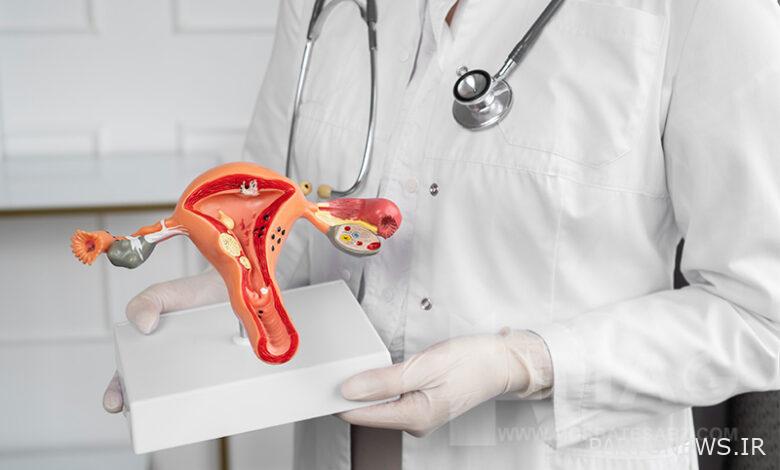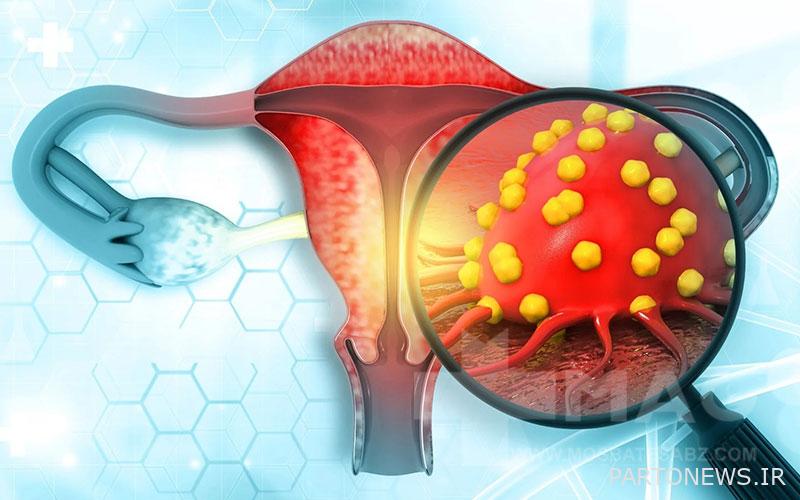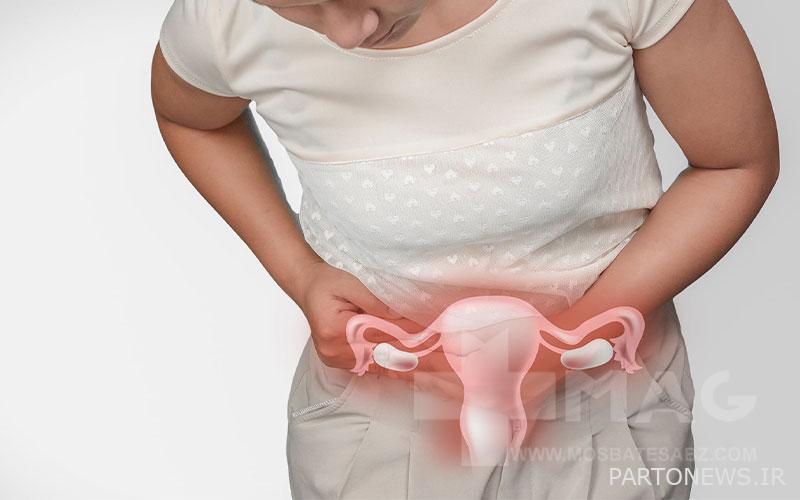What is uterine cancer? Everything you need to know about uterine cancer

Uterine cancer has different types and is one of the most common cancers among women. Bleeding between periods or after menopause is one of the most important symptoms of uterine cancer. Uterine cancer occurs when some of the normal cells in the uterus grow abnormally. In this article, we will explain everything about uterine cancer to you.
What we read in this article
What is uterine cancer?
The uterus is a part of the female body that is used for the growth and maintenance of the fetus. Women definitely need this organ for fertility. Uterine cancer occurs when the normal cells of the uterus turn into abnormal cells and grow abnormally. At any age, women may encounter uterine cancer, but research shows that the possibility of uterine cancer is higher in postmenopausal women than others. The uterus has two layers: a thin inner layer and a thick outer layer. Uterine cancer occurs mostly in the cells of the inner thin layer.
Types of uterine cancer
There are two main types of uterine cancer:
- One of the most common uterine cancers that occurs in the inner lining of the uterus is endometrial cancer. This cancer directly affects the reproductive system.
- Uterine sarcoma is another type of uterine cancer that can be considered rare. This cancer affects the muscular wall of the uterus.
Is endometrial cancer the same as uterine cancer?
Uterine cancer can refer to endometrial cancer or uterine sarcoma. But most people consider endometrial cancer and endometrial cancer as one. The reason is that endometrial cancer accounts for about 95% of all cases of uterine cancer, but uterine sarcoma is very rare, as we mentioned.
Symptoms of uterine and ovarian cancer
The symptoms of uterine cancer can be similar to many diseases; Especially diseases that affect reproductive organs. If you experience unusual pain or irregular bleeding from the vaginal area, you must see a gynecologist. Symptoms of endometrial cancer or uterine sarcoma are:
- Bleeding between periods
- Vaginal bleeding after menopause (even a small amount)
- Lower abdominal pain or cramping in the pelvis
- White or clear vaginal discharge during menopause
- Heavy and prolonged bleeding after 40 years old
Buy the best supplements for menopause now from positive green.
Symptoms of uterine cancer in postmenopausal women
Bleeding during menopause is the most important symptom of uterine cancer in postmenopausal women, in which case you should refer to a specialist in gynecological oncology. If uterine cancer is diagnosed at a stage where it has spread to other organs, the survival rate is 16-45%. But if uterine cancer is detected at an early stage, the chance of survival increases by more than 95%.
Cervical cancer symptoms
The cervix is the lower part of the uterus where the uterus meets the vagina. Cervical cancer is called cervical cancer. Cervical cancer symptoms include:
- Bleeding between periods
- Vaginal bleeding after sex
- Vaginal bleeding after menopause
This type of cancer can have no symptoms in the early stages.

What is the cause of uterine cancer?
Researchers and doctors do not know the exact cause of uterine cancer. There is a factor that causes changes in the cells of the uterus and disrupts their normal growth. In this case, cancer cells in the uterus multiply uncontrollably and may form a mass called a tumor.
Factors that increase the risk of uterine cancer
There are several factors that increase the risk of endometrial cancer. Many of these factors are related to an imbalance between estrogen and progesterone. These risk factors include obesity, polycystic ovary syndrome, Lynch syndrome, and estrogen use (without progesterone use).
Also, the following factors increase the risk of uterine cancer:
- Age: With increasing age, the probability of developing uterine cancer increases. Most uterine cancers occur after the age of 50.
- A diet rich in unhealthy fats: A high-fat diet can increase the risk of several types of cancer; including uterine cancer. Also, fatty foods can cause obesity and chronic diseases due to high calories.
- Family history: Some people inherit genetic disorders and have an increased risk of cancer. In people with Lynch syndrome or hereditary non-polyp colorectal cancer, the risk of endometrial cancer increases.
Also, diabetes, overweight and ovarian diseases can also reduce the risk of uterine cancer. People with ovarian tumors experience high estrogen levels and low progesterone levels. These hormonal changes can increase the risk of uterine cancer.
Click to buy menstrual pills to regulate periods or prevent premenstrual syndrome.
The relationship between menstruation and the risk of uterine cancer
- First menstruation: If a person experiences his first menstruation before the age of 12, the risk of uterine cancer increases. Because the body is exposed to estrogen for a longer time.
- Late menopause: In women whose menopause occurs after the age of 50, the risk of uterine cancer also increases because the uterus is exposed to estrogen for a longer period of time.
- Long menstrual period: The number of years a person has had periods may be more important than the age at the start or end of menstruation.
- Not getting pregnant: Women who have never been pregnant have a higher risk of developing uterine cancer.
The effect of treatment of some diseases on uterine cancer
- Pelvic radiation therapy: Pelvic radiation therapy to treat other cancers can damage cell DNA and increase the risk of uterine cancer.
- Estrogen replacement therapy: Some people take estrogen therapy to help improve menopause symptoms. Taking ERT without progesterone puts people at risk of uterine cancer.
- Use of Tamoxifen: This drug is usually used to treat breast cancer. This drug acts like estrogen in the uterus and increases the risk of uterine cancer.
What are the complications of endometrial cancer?
Endometrial cancer can lead to death, but not if it is detected in the early stages. Other complications of endometrial cancer include:
- Anemia
- Metastasis or spread of cancer to other parts of the body
- The body does not respond to the usual treatments

Life expectancy of uterine cancer patients
In general, it can be said that the life expectancy of uterine cancer patients depends precisely on the stage of cancer in which the disease is diagnosed and the treatment begins. Statistics show that 70% of women with uterine cancer have a chance to survive 5 years later. But if the cancer is diagnosed in the early stages, the percentage of women who have a chance to survive for the next 5 years reaches 90%. If uterine cancer is not diagnosed on time, 49% of patients will not survive for the next 5 years.
Is uterine cancer dangerous?
Uterine cancer is dangerous and deadly when it is not diagnosed and spreads in the body. When metastasis occurs and uterine cancer affects other organs, the chance of survival decreases by 17%. Early diagnosis and timely treatment can make the risk of uterine cancer much lower and a person can live longer.
Uterine cancer treatment
Most people with endometrial cancer need surgery. The type of uterine cancer treatment may be different from one person to another because the individual’s condition is very decisive in terms of health and the stage in which the cancer is located. Common treatments for uterine cancer include:
- Chemotherapy in which strong drugs are used to kill cancer cells.
- Radiation therapy, in which radiation is used to target cancer cells.
- Hormone therapy in which hormones are used or hormones are blocked.
- Immunotherapy that helps the immune system to fight cancer.
- Targeted therapy in which specific drugs are used to target cancer cells to prevent them from multiplying.

Malignant uterine cancer
Endometrial carcinoma or malignant uterine cancer is the most common cancer related to the reproductive organs of women. After breast, lung and colorectal cancer, endometrial cancer is the fourth most common cancer in women. This cancer ranks eighth among the causes of death from malignancy.
Stages of uterine cancer
When the necessary tests are done to diagnose uterine cancer, the type of this cancer is determined:
- Endometrial cancer type 1: is less aggressive and usually does not spread quickly to other parts of the body.
- Endometrial cancer type 2: more aggressive and more likely to spread outside the uterus. There is a need for stronger treatment for this type of cancer.
Stages of uterine cancer are:
- Stage 1: The cancer is only in the uterus and has not yet spread.
- Stage II: Cancer has spread to the cervix.
- Third stage: In this stage, the cancer has spread to the vagina, ovaries or lymph nodes.
- Stage 4: Cancer of the uterus, bladder or other organs around the uterus has been involved.
In some cases, the doctor may not be able to determine the stage of uterine cancer until surgery.
Complications of uterine surgery due to uterine cancer
Side effects of uterine cancer surgery include:
- Infertility or inability to conceive
- Menopause and its related symptoms such as: sweating and hot flashes or vaginal dryness.
Prevention of uterine cancer
In most cases, you cannot prevent uterine cancer because, as we said, the exact cause of uterine cancer is not known. However, the following actions are recommended:
- Diabetes management and prevention
- Maintaining a healthy weight and preventing overweight
- Consult your doctor about the use of hormonal contraceptives based on progesterone or a combination of estrogen and progesterone. These drugs can have a protective effect against uterine cancer to some extent.
Also, don’t forget a healthy lifestyle to prevent uterine cancer and other types of cancer.
We suggest you read this article: Leukemia, review of the most important symptoms and treatment
Uterine cancer diagnosis methods
One or more of the following may be done to diagnose uterine cancer:
Blood test for uterine cancer
CA-125, which is a type of protein, should be tested. Certain amounts of this substance can indicate uterine cancer.
Imaging tests
- CT scan, which provides accurate images of the inside of the body.
- MRI: Radio waves and a powerful magnet are used to create images.
- Transvaginal ultrasound: A device is inserted into the vagina to take pictures of the uterus.
The following tests may also be required:
- Endometrial biopsy: A thin and flexible tube is inserted into the uterus through the cervix to take a sample.
- Hysteroscopy: A long, thin tube is inserted through the vagina and cervix to provide detailed images of the inside of the uterus with a light and camera.
- Dilation and curettage: It is a more complicated procedure to remove the uterine tissue, which is done in the operating room.
If sampling is done through dilation and curettage or biopsy, the sample must be sent to the laboratory so that the pathobiologist can check the possibility of uterine cancer.
final word
In this article from Positive Green Online Pharmacy magazine, we investigated uterine cancer, its symptoms, treatment methods, life expectancy of affected patients, etc. By visiting a gynecologist regularly (twice a year) and providing the necessary tests, you can prevent the spread of uterine cancer in its early stages. We hope this article has been of interest to you.

